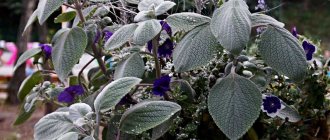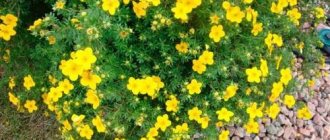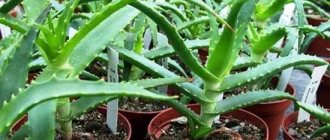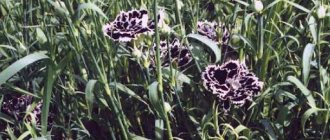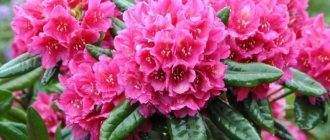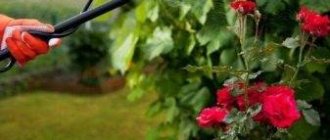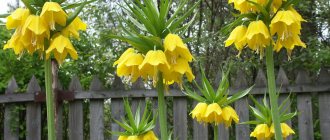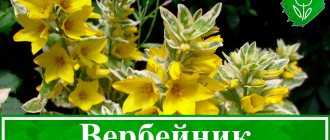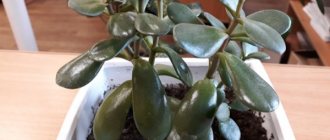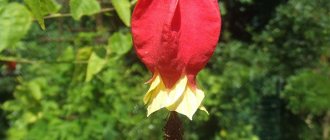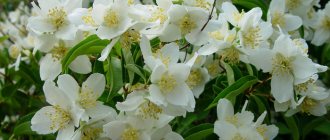Maple is extremely popular because of its appearance, especially in the fall, when its leaves turn fiery red, orange or yellow. This genus consists of more than 150 species. It can be presented in the form of a tree or shrub. In our article we will tell you about the most popular types and varieties of maple, give their brief characteristics and some tips on growing.
Norway maple or sycamore (Acer platanoides)
It is one of the most popular types of maple and is very often found in parks and forests. It is characterized by rapid growth rates, which makes it possible to create green fences and decorate parks from it in a relatively short period of time. In early spring, resinous buds form on the branches, which after some time turn into leaves. The leaves have a five-lobed configuration, are large in size, each blade ends with a sharp end. Depending on the season of the year, the leaves can be light green, green, yellow, orange-red, red or brown. The leaf surface is permeated with clearly defined veins. The tree can grow more than 30 m in height.
Young shoots are covered with smooth red-brown bark. Old shoots are distinguished by bark with cracks and a brownish-grayish color. The crown is spreading and dense. During flowering, the trees are covered with green or yellow small flowers that form shield-shaped inflorescences. Flowering begins in April-May. The flowers bloom before the leaves are formed, so during flowering the tree looks very beautiful and stands out from other trees. Flowers also release a pleasant sour-honey aroma that attracts insects. There are different types of flowers on the same tree. These plants are considered honey-bearing; each flower contains a large amount of nectar. Maple honey is light yellow in color, has a pleasant aroma and exquisite taste. At the end of flowering, seeds are formed, which are attached to two-lobed wings. After the seeds ripen, they tear off the branch and are carried by the wind over large areas. After overwintering under a layer of foliage, the seeds germinate in the spring and cover the soil with young shoots.
Caring for unpretentious abutilone
Most often, domestic gardeners choose striped abutilon as a houseplant. It grows quickly, and the flowers do not fall off for a long time. This is the most common type of houseplant in Russia, similar to maple.
Abundant watering should be combined with regular loosening of the soil.
The list of basic care activities includes:
- abundant watering;
- regular loosening;
- pruning;
- removal of dried flowers during the flowering period;
- spraying leaves with water;
- fertilizing with fertilizers for indoor plants.
Note! If the winter turns out to be cold, it is recommended to reduce the frequency of watering until the weather warms up, otherwise the plant may not bloom. From a lack or excess of moisture, the leaves of the rope plant may dry out and fall off.
Experts recommend protecting the flower from direct sunlight. Ropeweed grows well in the shade, but on a south window. In May - August, when abutilon blooms, it is better to move the plant to a balcony or street terrace. Also, indoor maple will feel good in a summer cottage among the grass, in the shade of fruit trees.
To make your indoor maple look beautiful, you should regularly pay attention to the formation of the crown. Pruning should be done twice a year, in April and October. To make the bush compact, you need to remove all the branches, leaving a single stem. If you want to have a spreading tree, young shoots are pinched from above. During pruning, remove all dried, deformed flowers and leaves, as well as shoots affected by pests or diseases.
The ropetail often suffers from whitefly and spider mite infestations. To get rid of pests, you can use a soap solution or industrially produced insecticides.
Sometimes indoor maple leaves suddenly begin to turn yellow and curl into a tube, and the shoots dry out at the ends. In this case, it is recommended to increase watering and spray the leaves daily with water from a spray bottle for additional moisture. If the soil in the pot is dry, you need to place the flower pot in a basin filled with warm water for half an hour. This measure will help to urgently resuscitate the cable car.
It is recommended to transplant into a larger container in the spring. The optimal frequency of replanting adult plants is once every three years. The new pot must be doused with boiling water to kill all bacteria and viruses. A drainage layer is placed at the bottom, then it is covered with soil for indoor flowers. Abutilone is carefully removed from the old vessel, transferred to a new one, covered with earth and watered abundantly. Before doing this, you need to carefully look at the roots of the plant. If they have not grown much, it is recommended to postpone replanting until the fall, waiting until the end of flowering.
For your information! Seeds for planting are sown in containers with sand and peat in the second ten days of March. The sowing depth is 6-9 mm. Containers must be covered with a lid or plastic wrap to create a greenhouse effect. Shoots should be expected in a month. The plant blooms for the first time approximately six months after planting.
Before sowing, it is recommended to place indoor maple seeds in a vessel with water. The seeds that float will not sprout, so you can throw them away. The largest seed material is selected for planting. For germination to be high, the air temperature must reach 22-27°C. If the soil dries out, you can spray it with warm water.
In order for abutilon to delight with its flowering for a long time, it must be grown in a warm room on a bright, spacious windowsill. It can be planted at home, in the office or in a winter greenhouse. The main thing is to water the southern “guest” more often, and he will certainly thank you for your care with large, bright flowers. If the summer is hot, a maple tree in a pot will grow well on a balcony or in a summer cottage.
Ash-leaved or American maple (Acer negundo)
This tree is considered one of the most unpretentious and hardy of its kind, therefore it is often used for planting in large cities. The plant is also characterized by increased resistance to dust and gas, and has enhanced regeneration properties. This maple grows in height up to 15-20 m, has a trunk circumference of about 40-60 cm. The crown has slightly drooping shoots, develops unevenly, the trunk is slightly curved, covered with gray bark with small grooves. The leaves are arranged oppositely on long petioles, have 3-7 lobes, a length of 15-17 cm, an odd-pinnate configuration and a light green color.
The culture blooms with dioecious flowers: male flowers open earlier than female ones. The aroma of flowers attracts bees, which take nectar from them for honey. Flowering occurs in late spring early summer and lasts for 2 weeks. The flowers are small green in color and bloom along with the leaves. At the end of flowering, fruits are formed, consisting of a seed and an impeller. Full ripening of the fruits occurs in mid-autumn, but they continue to hang on the shoots until spring. More than 500,000 lionfish form on one tree. The average lifespan of a tree is 80-100 years in the wild; in growing conditions under unfavorable factors it is about 30 years.
Community of little green men
Acer, Maple. Trees and shrubs with opposite buds and simple, usually palmate or entire or pinnately compound leaves without stipules. Flowers are bisexual or unisexual (due to underdevelopment of the pistil or stamens). The fruits are lionfish with an elongated wing. Flowers in panicles or corymbs.
Etymology
The name is derived from the Latin acer - “sharp”, from the shape of the leaves with sharp blades.
Types and varieties of maple
The genus contains about 150 species, distributed in North America, Asia, Europe and North Africa, mainly in areas with temperate climates. There are 16 species growing in our country. About 40 species are used in ornamental gardening.
Types and varieties of maples
Norway maple, or sycamore maple (Acer platanoides)
Homeland - European Russia and the Caucasus.
Norway maple reaches a height of 30 m, the bark is fissured, at first dark gray, later turning black. It blooms in mid-May, at the same time as foliage.
The species is demanding on soils, does not tolerate stagnant moisture and salinity, and is wind-resistant.
USDA Zone 3 (4)
Norway maple, or sycamore maple, Acer platanoides
Decorative forms and varieties of Norway maple:
'Albescens' is a large deciduous tree with a broad oval crown, young leaves are creamy white, mature leaves are green;
'Bicolor' - young leaves are light yellow with cream strokes, later they turn pink;
‘Cleveland
' - characterized by a compact crown shape, when blooming the leaves are light red, then bright green, autumn color is yellow-orange;
'Columnare'
- up to 10 m high, with a columnar crown shape, characterized by a slow growth rate. The leaves are red when blooming, later dark green;
Plantain maple Crismon Sentry or Crimson Sentry is a slender tree, up to 7-8 m high with dark red leaves
'Crimson King' has purple leaves throughout the season;
'Drummondii' - a tree up to 5 m high, distinguished by a wide cream border on the leaves;
'Emerald Queen'
- up to 12-15 m high, distinguished by an oval crown shape and leaves that, when blooming, become light red, then acquire a dark green color, and light yellow in the fall;
'Faassen's Black' - young leaves are light red, mature leaves are dark purple (almost black);
'Fairview'
— the variety is distinguished by its pyramidal crown shape and dark green leaves;
'Farlakes Green'
— the variety is distinguished by a wide pyramidal crown, bright yellow autumn and dark green summer leaves;
'Fassen's Black'
— the variety is distinguished by a regular wide-pyramidal crown and large red-brown leaves;
'Globosum'
— the variety is distinguished by a dense, spherical crown shape;
'Maculatum' - low tree, young leaves with small white and pink strokes;
Norway maple or sycamore variety 'Royal Red' is distinguished by large, bright red leaves during the growing season
'Schwedleri'
— the variety is distinguished by shiny red young leaves that change color from bronze-green in summer to orange-copper in autumn;
'Variegatum' - young leaves with pink strokes, then they turn white.
Norway maple flowering
Field maple, or oaklen (Acer campestre)
Homeland - forest-steppe of the European part of Russia, Crimea and the Caucasus.
Tree or shrub up to 15 m high with a dense, spreading, tent-shaped crown. The bark is light gray, the shoots and buds are pubescent, the leaves are smaller than those of K. holly.
Field maple is shade-tolerant and drought-resistant. It is preferable to plant it in places protected from the wind. In winter hardiness it is inferior to Norway maple. It tolerates pruning better than other maples.
USDA Zone 3 (4)
Field maple, or oaklen, Acer campestre
Popular varieties of field maple:
'Albovariegatum' is usually a shrub, about 5 m tall with white-variegated leaves, yellow in autumn;
'Carnival' - young leaves with a wide pink border, then the border turns white;
'Elsrijk' - a tree, up to 8 m tall with a compact conical crown and small leaves;
'Red Shine' - tree up to 5 m tall with purple leaves;
'Postelense' is a low tree with a wide and low crown, the bark is brownish with longitudinal cracks, the leaves are first golden-yellow, then green, and yellow in autumn;
'Pulverulentum' - young leaves are creamy, mature leaves have a lot of white spots.
Maple mono, or small-leaved maple (Acer mono)
Far Eastern view.
A tree up to 15-20 m high with a dense and low crown, leaves smaller than those of Norway maple. Young branches are yellowish-gray, old ones are brown. The leaves are five-lobed, small, dense. The flowers are light yellow (May), collected in paniculate inflorescences. The fruits ripen in August. Autumn foliage color is bright yellow, orange and red.
The popular variety 'Marmoratum' is a low tree with a rounded crown, gray bark, leaves with white spots of various sizes, yellow in autumn.
USDA Zone 4
Mono maple, or small-leaved maple, Acer mono
Red maple, scarlet maple or swamp maple (Acer rubrum)
A fast-growing deciduous tree with a spreading tent-shaped crown, up to 15-20 m tall in cultivation, in nature up to 30-40 m. The bark is dark gray, young shoots are reddish. The leaves are five-lobed, reddish when blooming, and during the summer they are rich green on top and whitish on the underside. In autumn the foliage is bright orange.
Red maple is quite frost-resistant and undemanding to soil conditions. Grows well in urban conditions, on uncompacted soils. Not affected by powdery mildew.
Decorative varieties of red maple or swamp maple:
'Armstrong' - the variety is distinguished by a column-like crown shape and smaller foliage;
'Bowhall' - the variety is distinguished by a narrow pyramidal crown shape and bright orange foliage in autumn;
'Brandywine' - the variety is distinguished by its rich, even purple, foliage color in autumn;
'Karpik' - the variety is distinguished by the regular columnar shape of the crown and the bluish color of the foliage;
'Northwood' - the variety is distinguished by very bright autumn foliage color - red and orange;
'Autumn Flame' - variety has bright red autumn foliage;
'Red Sunset' - the variety is distinguished by a pyramidal crown shape and large purple leaves in autumn.
USDA Zone 4
Ginnala maple, or river maple (Acer ginnala)
Homeland - forests of the Far East.
Shrub or tree height from 2 to 5-7 m. The bark is brown. The leaves are oblong, three-lobed, pinkish when blooming, mature dark green, bright red or orange in autumn. The flowers are yellowish, fragrant. The fruits are lionfish, bright pink before ripening. The species is light-loving and frost-resistant.
The 'Flame' variety has an unusually beautiful autumn leaf color, and the 'Durand Dwarf' variety is only 50-60 cm high, the leaves are small, the autumn color is very bright.
USDA Zone 3
Ginnala maple, or river maple, Acer ginnala
Palm maple or fan maple (Acer palmatum)
Shrub or small tree up to 8 m tall, with a round or umbrella-shaped crown. The leaves of this maple are strongly dissected, lobed, bare, up to 12 cm in diameter, very decorative: red when blooming, green in summer, purple in autumn.
It grows slowly, is demanding on soil and moisture, suffers from dry air, is quite thermophilic, and regularly freezes, sometimes to the level of snow. Prefers fertile, humus-rich, well-drained acidic or neutral soils. It is possible to grow in a container culture with winter maintenance at low positive temperatures.
USDA Zone 6 (7)
Fan maple variety 'Butterfly' is a low-growing variety with small, gray-green leaves with a white or pink border along the edges of the leaves. Can be used for winter shelter.
Popular varieties of palm maple:
'Aureum' - shrub up to 1 m tall, young leaves are light yellow with a reddish edge, yellow-green in summer, yellow in autumn;
'Atropurpureum' - about 2 m high with highly lobed, dark purple throughout the season;
'Dissectum' - a group of varieties in which the leaves are divided to the base into pinnately divided lobes: 'Dissectum Flavescens' - leaves are yellowish-green in summer and yellow in autumn;
'Deshojo' - maple is distinguished by the crimson-red color of young leaves, later they become light green;
'Okushimo' - the variety is distinguished by green foliage;
'Ornatum' - the variety is distinguished by the color of the leaf blade: red-brown - green-brown - fiery scarlet, depending on the season: spring - summer - autumn.
Sugar maple, or silver maple (Acer saccharinum)
A large North American tree with a tent-shaped, spreading crown in nature up to 40 m, in cultivation up to 25 m in height. The bark is light gray. The leaves are five-lobed, heavily indented, bright green, silvery-white underneath, turning light yellow or pinkish-orange in the fall. The flowers are greenish-yellow (April), the fruits ripen early.
It grows quickly, is shade-tolerant, and is quite undemanding to soil.
In their homeland, the sap of sugar maple and sugar maple is used for the industrial production of maple sugar.
USDA Zone 3 (4)
Sugar maple, or silver maple, Acer saccharinum
Popular varieties of sugar maple:
'Aureo-variegatum' is a deciduous tree with a wide spreading crown, the leaves are silvery below, with yellow strokes above, with an orange tint when blooming;
'Citreo-variegatum' - young leaves yellow-green;
'Vagneri' is a low-growing variety, the leaves are small, with a small white border;
'Hance's Variegated' has leaves with creamy white streaks.
Manchurian maple (Acer mandshuricum)
A slender tree up to 20 m high. The crown is openwork, usually raised high. The bark is gray, young shoots are red-brown, glabrous. The leaves are dark green, compound, trifoliate with reddish petioles. The flowers are greenish-yellow, collected in corymbose inflorescences. In summer the leaves are often reddish along the veins and along the edges, in autumn they are deep red. Blooms in May, bears fruit in September.
The species tolerates some shade, but develops better in sunny places. The soil is preferably fertile, the species is winter-hardy.
USDA Zone 4
Manchurian maple in autumn
Tatarian maple, black maple or non-maple (Acer tataricum)
Shrub or tree with a spreading crown, up to 9 m high. The bark is smooth, almost black. The trunk is gracefully curved. The leaves are entire, up to 10 cm long, dark green in summer, yellow or red in autumn. The flowers are white, collected in dense panicles. The fruits are lionfish, remain on the tree for a long time and are colored red in summer.
Tatarian maple is winter-hardy, drought-resistant and undemanding to soil conditions. Tolerates haircuts well.
USDA Zone 3
Tatarian maple or black maple
Flowering Tatarian maple
Greenbark maple (Acer tegmentosum)
This species grows in the Far Eastern taiga forests, China and Korea. It was introduced into culture in 1892.
A tall shrub or tree in nature up to 15 m high. The bark is smooth green with longitudinal whitish stripes. Leaves are up to 17 cm long, yellow in autumn. Blooms in the second decade of May. Flowering and fruiting begins at the age of 9 years.
Greenbark maple grows quite quickly, prefers sunny places, but also tolerates slight shading. Does not need pruning. Frost-resistant.
Greenbark maple
Blooming green maple
Ash-leaf maple, or American maple (Acer negundo)
Homeland - North America. This North American species has successfully adapted to the climatic conditions of Russia.
A tree up to 20 m tall, often multi-stemmed, with a wide spreading crown. The bark is light brown. The bark of young shoots is covered with a bluish waxy coating. The leaves are compound, consisting of 3–5 leaflets. It blooms in May, the fruits ripen in September.
The species is extremely unpretentious, light-loving, and undemanding to soils. It reproduces well by self-sowing and grows quickly and weeds at a young age.
USDA Zone 3
Popular forms and varieties of ash maple:
'Auratum' - tree up to 7-10 m tall, spreading crown, young foliage bronze, later lemon yellow;
'Elegans' - up to 5 m, young leaves with a bright yellow edge, adult leaves with white;
Ash-leaved maple variety Flamingo or Flamingo - up to 5 m tall, leaves with white and pink patterns
'Aureo-Variegatum' - the variety is distinguished by the color of the leaves: dark green with golden-yellow spots, light-loving;
'Odessanum' - bronze-colored leaves when blooming, later becoming bright, golden yellow;
'Variegatum' - the leaves are pink when blooming, then with a white border or random streaks.
Pennsylvania maple, or striped maple (Acer pensylvanicum)
Tree up to 12 m tall, the bark is smooth, dark green, with longitudinal whitish-green stripes. It grows slowly. K. Pennsylvanian is a shade-tolerant species, undemanding to soils and frost-resistant.
Curly maple (Acer circinatum)
Homeland - territory along the Pacific coast of North America.
A low tree with spreading shoots, often growing as a bush. The leaves are round in outline, have 7-9 lobes, each with a serrated edge. The leaves reach 6-12 cm in diameter. Blooms in the first half of May. The flowers are red, collected in drooping racemes.
Frost-resistant, annual shoots can freeze.
Curly maple varieties:
'Little Gem' is a dwarf variety with a rounded crown. The leaves are small, with a reddish tint when blooming, and red and orange in the fall;
'Monroe' - purple branches, leaves dissected to the very base into wide coarse-toothed lobes, orange-yellow in autumn;
'Pacific Fire' - bright red branches, leaves turn yellow in autumn.
False Siebold maple (Acer pseudosieboldianum)
Homeland - Far East.
A low, no more than 8 m tall tree with a dense spherical crown. Blooms in mid-May. The leaves are fan-shaped, medium-sized, nine-lobed. In summer they are light green, in autumn they are yellow, pink and red.
Winter hardiness is high, but in severe winters, annual shoots can freeze.
Naked maple (Acer glabrum)
A small tree or shrub several meters high. Young branches are dark, reddish-brown, later turning gray. Leaves are up to 5-6 cm long, 3-lobed, on red petioles, dark green above, bluish below, yellow in autumn. The flowers are greenish-yellow. Unripe fruits are red.
Yellow maple (Acer ucurunduense)
A small tree or shrub up to 8 m tall, with a narrow crown. Leaves are up to 14 cm wide, with 5-7 lobes, the lobes are oval, long pointed, with rough teeth. The leaves are dark green, orange and red in autumn. Blooms after the leaves bloom. Small flowers are collected in long and narrow protruding racemes up to 15 cm long. The wings of the fruit are compressed.
Maple care
Maples are demanding on soil (they act as soil-improving species). On swampy soils and when groundwater is close to each other, drainage is necessary. The soil mixture for maples that require fertile soil includes humus, turf soil and sand (3:2:1); for less demanding ones, leaf soil, peat and sand (2:2:1) are suitable.
Maples are relatively shade-tolerant and wind-resistant. They grow slowly, many species are drought-resistant, but maples need to be watered in hot weather.
It is necessary to cut out dry branches and frost-damaged annual shoots.
Most species overwinter without shelter, however, some species, such as K. palmate, are heat-loving and in central Russia require shelter for the winter.
False sycamore maple
Maple propagation
Maples are propagated by sowing, and decorative forms by grafting.
False-platan maple Simon-Louis Fréres or Simon-Louis Fréres is a tree up to 20 m tall with a dense crown. The variety is close to the famous Leopoldi variety. The leaves are cream when they bloom, then light green with a creamy white and green pattern, when mature they are even more contrasting.
Field, plain or Neklen maple (Acer campestre)
This type of maple is used for park plantings due to its medium growth. In addition, it is very undemanding to growing conditions and does well in urban conditions of gas pollution and dust. The tree grows up to 12-20 m in height and is characterized by a broadly conical crown consisting of bright green five-lobed leaves. After all the leaves on the tree have blossomed, flowering begins. Flowers cover the crown and give the tree a very decorative appearance. The trunk is covered with light brown bark with light white stripes. This species is slightly frost-resistant and prefers to be grown in warm climates. Bonsai is often made from this species, since the tree tolerates cutting and shaping well. The plant has stable immunity against diseases and damage from insect pests. The root system is very powerful and branched, thanks to which the tree tolerates drought and soil compaction well.
This species has several varieties that differ in popularity:
- Field maple Elisriysk. A tree of this variety grows up to 8 m in height. It has a dense crown of a spherical configuration. The crown circumference is about 5 m. The shoots are covered with large five-lobed leaves. The leaves bloom in mid-spring and are reddish in color. When grown in the sun, they change color to yellow. When grown in the shade - green. During flowering, small yellow-green flowers bloom, collected in corymbose inflorescences. At the end of flowering, two-winged seeds are formed.
- Field maple Red Shine. This tree is short in stature, about 5 m. Its crown and spreading trunk are covered with gray bark. The leaves are large, multi-lobed, and have a red-purple color. It blooms with yellow or green flowers collected in medium-sized inflorescences.
- Field maple albovariegatum. This variety is characterized by trees no more than 5 m high. It is used to create hedges. It has a strong trunk and a wide branched crown, which is formed from the bottom of the trunk. The bark is silvery in color and covered with small cracks. The large leaves are light green in color, changing to yellow in the fall.
- Field maple Queen Elizabeth. This variety is characterized by fast growth rates and vertically growing shoots that form a narrow pyramidal crown configuration. The crown circumference reaches 10 m, the height of the tree is 80 m. Due to the shape of the crown, this variety is often used to decorate alleys and garden parks. In mid-spring, the shoots are covered with large leaves that are light green in color. The plant feels good when grown in shaded areas, but cannot grow in marshy soil. It also tolerates gas and dust in the atmosphere well, which is why it is often grown in large cities.
- Red field maple. It has a slow growth rate, grows up to 8 m in height. It has a decorative branched crown. The tree got its name due to the fact that its young branches are dark red in color. During flowering, the entire crown is decorated with small green-yellow flowers that form racemose inflorescences. At the end of flowering, lionfish about 3 cm long are formed, which consist of one large seed. The palmate leaves are olive green in color. The root system is branched and located in the upper layers of the soil. Reproduction occurs by root shoots or by seeds.
- Field maple spherical. This variety got its name due to the spherical shape of the crown. The tree is characterized by slow growth and grows to a height of no more than 5 m. Young leaves have a red-orange color, changing to golden yellow in the sun. The flowers are small yellow-green, forming paniculate inflorescences. Lionfish fruits. The root is highly branched and grows in the upper layers of the soil. The crop is propagated by root shoots, seeds or grafting.
Durand Dwarf
Durand Dwarf is an ornamental form of maple that is a small shrub-like tree with dense branches. Its height is up to 1.5 meters, and its width reaches 2 meters.
The three-lobed, medium-sized leaves are oval-oblong and pointed at the ends. When blooming, the foliage is painted in pink-red shades, later it takes on a dark green color. In autumn they turn yellowish-orange, pink or bright red. Flowering occurs in May, when the leaves have already blossomed; small fragrant flowers are painted in yellow tones and collected in oval inflorescences on long petioles.
The winged fruits are about 3 cm long, they are green in color, and in the sun they acquire a bright red blush. The shrub has a wide crown, its root system is shallow and is capable of producing abundant young growth.
The species tolerates replanting, shaping, and growth in urban environments well. It is not picky about the soil, but needs timely watering. Maple is light-loving, but can grow in partial shade.
Narrow-crowned sycamore maple (Pseudoplatanus 'Erectum')
This species was bred in Holland in 1935. Its representatives grow up to 25 m in height, however, the crown is only 8 meters. Young trees have a columnar crown configuration, while older trees have an oval shape. The leaves are large, leaf length is about 30 cm, attached to short thick petioles. The flowers are formed in umbellate inflorescences and are yellow-green in color. Trees prefer to be grown in shaded areas, in loose, fertile soil.
Drummondii
The Norway maple reaches a height of 10-12 meters, the width of its crown is 5-7 meters; the tree reaches this size if it grows for about 30 years in one place. Growth is moderate - about 30 cm per year, the crown is wide-pyramidal and dense.
Five-lobed leaves of medium size, clearly defined, with sharp edges, change color three times per season. When blooming, the foliage is painted in a soft pink color, later it acquires a light green tint with a uniform white border.
In autumn, the leaves turn yellow or brown. The tree prefers loose, fertile soil with sufficient moisture. It does not tolerate overdried soil, stagnant moisture and salinity.
River maple (Acer ginnala)
Trees of this species are about 10 m high. The stems grow vertically, have a thin shape, the trunk is short, covered with light brown thin bark. The bark of mature trees does not develop deep cracks. The leaves are simple in shape, green in color, and have a glossy shine. By autumn they change their color to red or yellow-orange. Flowering occurs simultaneously with the formation of leaves. The flowers are green-yellow in color and form racemose inflorescences. At the end of flowering, winged fruits are formed, which are red in color. This variety is characterized by high frost resistance, drought resistance and wind resistance. Propagated by seeds.
Sycamore maple (Pseudoplatanus 'Negenia)
This is a fast-growing type of maple, which reaches a height of about 30 m. The diameter of the crown does not exceed 12 m. The crown has a wide pyramidal shape, consists of large dark green leaves covered with clearly defined veins. The leaves are held on short red petioles. The flowers are green or yellow, fragrant, and contain a large amount of nectar. Lionfish fruits. Sycamore maple is widely used for landscaping streets and city parks; it can grow on any type of soil and is a wind-resistant, frost-resistant plant. Propagated by seeds or vegetatively.
Purple-leaved sycamore maple (Psevdoplatanus 'Atropurpureum')
A fast-growing deciduous tree about 30 m high, with a 15-meter wide conical crown. The leaves are five-lobed, each lobe has a sharp end. When blooming, the leaves have a brownish-red color, which changes to dark green. The back side of the leaf is covered with thick red hair. At the end of flowering, winged fruits of a dark red color are formed. The tree can be grown in urban gas and pollution conditions. It is frost-resistant and likes to be grown in open, sunny places.
Diseases, pests and problems when growing abutilone
Although it is believed that indoor maple is unpretentious in care, like many plants it can be susceptible to diseases, shed leaves or suffer from attacks by harmful insects. Common pests include:
- aphid;
- spider mite;
- sooty fungus;
- whitefly;
- scale insect
To combat pests, acaricides and a soap solution are used to wipe the leaves.
Also, the soil should not be allowed to dry out - this will cause the leaves of the plant to begin to wither and fall off. In low humidity conditions they may turn yellow and curl into a tube.
Sycamore maple (Pseudoplatanus 'Rotterdam')
This species was bred in Rotterdam and is a rather valuable plant species. The tree is large, has a cone-shaped branched crown, which takes on the shape of an ellipse at the age of 5-7 years. In winter, the trunk is covered with green bark. The leaves have the same length and width, which is 10-13 cm. The size of the leaf differs depending on where it grows. The trunk leaves are smaller in size. The leaf blade is dark green and has many bright veins. These trees are slightly frost-resistant; they like to be grown in semi-shaded places and in the sun.
Pulverulentum
This type of maple reaches a height of 12 meters and has a spreading, dense crown. The leaves have soft outlines and change color depending on the height of the location - a darker shade predominates on top than on the bottom.
The leaves can be three or five lobed and vary greatly in shape and size. They are colored light green and covered with white and cream specks. Flowering occurs after the foliage opens, the yellow-green small flowers bloom for 10-15 days.
After planting cuttings in open ground during the first winter, they must be covered. Maple grows slowly, tolerates drought and urban conditions, but cannot withstand stagnant moisture.
Acer divergens Pax
This type of maple is native to Türkiye and Armenia, where it can be seen on dry slopes. The height of such a tree does not exceed 4 m, the crown circumference is no more than a meter. Refers to slow-growing deciduous trees, the growing season of which begins in April and ends in November. Flowering occurs in May and lasts for 7-10 days. Fruits are formed on trees that are 10 years old. This species is very frost-resistant, able to tolerate frosts of more than 25 degrees.
Japanese maple (Acer japonicum Aconitifolium)
Representatives of this species are distinguished by trees that grow no more than 5 m in height. The shoots are covered with decorative leaves of light green color up to 15 cm long. The crown has a cone-shaped configuration. Flowering occurs at the end of April, the tree blooms with green-yellow flowers collected in racemes. The root is widely branched and grows in the upper layers of the earth, so the plant reacts painfully to swampy and waterlogged soils. Likes to be grown in open sunny places in fertile, loose soil. Does not tolerate pruning well.
Maple varieties on a trunk
Regular rounded shrub shape of Norway maple Globosum
and good frost resistance allow this variety to be grafted onto a standard, creating an incredibly attractive specimen for planting in a landscape composition, alone against a lawn or in an alley planting. One of the few varieties that categorically does not tolerate stagnant moisture, and therefore it is recommended to choose sunny places for planting away from the lowlands. The diameter of the shrub itself can reach six meters, and therefore, with age, the thickening trunk will one day support a huge dense crown of numerous shoots, strewn with the classic five-lobed leaves of maple. Lush green in the summer months, they turn a pleasant shade of orange by autumn.
Norway maple Golden Globe
, like the previous representative of this species, is ideal for grafting onto a standard and looks incredibly decorative both in mixed landscape compositions and when planted along alleys. Growing up to six meters in diameter, it is also capable of forming a luxurious, dense crown of a regular spherical shape. The peculiarity of this maple is the bright and unusual color of the foliage: orange-yellow in the spring, it turns light green in the summer. And if the maple grows in a well-lit place, its crown will shimmer with golden-yellow hues in the summer months.
Coralbark maple (Acer palmatum 'Sangokaku')
This type of maple is represented by a shrubby plant growing in height up to 6 m. The variety was named due to the fact that young shoots have a bright coral color, the intensity of which intensifies in winter. The leaves are light green with a pink tint. The leaf blade is grayish, has a red edge along the edge. In autumn the leaves change color to bright yellow. It blooms with greenish-yellow flowers that form small inflorescences. The inflorescences densely cover the crown and give the tree a decorative appearance. Due to the shallow root system, the tree needs regular watering and reacts painfully to waterlogging and stagnation of water in the soil. It is also not recommended to reforge the area near the trunk with a bayonet shovel, so as not to damage the roots.
Norway maple Acer platanoides (also known as sycamore)
This form of maple is one of the most common in Europe. The tree is most often large (but there are also low-growing varieties), with rough, rough bark, a dense crown and leaves close to a triangular shape. Autumn leaves of Norway maple are most often painted in a simple yellow color; orange and red shades are not typical for it. The first 3-4 years it grows very quickly, then it slows down sharply, long-lived.
Norway maple is shade-tolerant and winter-hardy, loves moist, fertile, well-drained soils. It has many decorative garden forms (cultivars), differing in color, shape of crown and leaves, and growth characteristics. Let's look at the popular ones.
Norway maple Crimson King (Crimson King)
The foliage of this tree is dark purple, and the shade remains from the leaves blooming throughout the growing season, only darkening slightly. Both sunny and shady places are suitable for planting.
An adult tree grows up to 10-15 meters and grows slowly. The crown is wide-rounded, dense, uniform. The bark is gray, with clearly defined longitudinal furrows, darkens with age, the trunk is smooth. The leaves are large, five- or seven-lobed, smooth, shiny.
Norway maple Drummondii (Drumondi)
Maple is decorative with variegated foliage: when it blooms, it is pink in color, then turns into bright green with a wide white or cream border, and in the fall it becomes yellowish. Shade-tolerant, but in shaded areas the leaf becomes lighter and the edge narrower.
An adult tree grows up to 9-12 meters and grows slowly. The crown is broadly pyramidal or round, dense, uniform. The bark is reddish-gray, with clearly defined longitudinal furrows, becomes very dark with age, the trunk is even. The leaves are large, five- or seven-lobed, smooth, shiny, with finely toothed edges.
Norway maple Golden Globe (Golden Globe)
The young foliage of this maple, with a pink or orange-red hue, changes color during the summer months to soft green (if growing in partial shade) or bright yellow-gold (if growing in a sunny area). In autumn, the foliage color does not change.
An adult tree grows up to 4-6 meters and grows slowly. Standard forms are often grown. The crown is spherical (less often umbrella-shaped), medium dense, uniform. The bark is brownish-gray, dark, fissured, the trunk is smooth. The leaves are large, five-lobed, smooth, shiny, with serrated edges.
Norway maple Deborah (Deborah)
The foliage is reddish-purple with dark green jagged edges when blooming, turning deep bronze-green during the summer (with purple leaves remaining at the tops) and golden-copper in the fall.
An adult tree grows up to 5-15 meters and grows quickly. The crown is wide-rounded or rounded-pyramidal, spreading, dense. The trunk is smooth, dark gray in color, with clearly defined longitudinal grooves. The leaves are large, five- or seven-lobed, smooth, shiny, with serrated edges.
Yellow ash maple (Acer negundo 'Odessanum')
This tree has an average growth rate and grows to a height of about 6-7 m. It is characterized by the presence of fleecy white shoots. The leaves have a yellowish color and a shiny surface, forming a spherical and very dense crown. This variety is most often propagated by grafting. Flowers form in umbellate inflorescences that densely cover the stems. Trees are sensitive to soil compaction due to their shallow root system. Due to the strong branching of the root shoots, the plant tolerates strong winds well. It likes to be grown in open sunny places, but also does well in partial shade.
Types and varieties of maple
Sugar maple, or silver maple , is a monumental tree with a powerful crown. It grows fastest in open spaces. Does not mind wet soils. However, the branches of this tree are very brittle. Maple is very beautiful, especially its “Wieri” form with rugged leaves that make it delicate and light.
Photo gallery of maple species and varieties
Norway maple or plane-leaved maple - received this name due to the similarity of the foliage with the leaves of a plane tree. It has clearly defined foliage, a dense, neat crown, and an even, straight trunk.
Modern breeders based on Norway maple have created a huge number of varieties with unusually colored leaves or with a clearly defined crown shape. The spherical shape of the Norway maple is especially impressive - in the form of a dense green ball. In addition, new varieties have been developed with golden or purple foliage. The maple tree does not need special pruning (just remove broken and dried branches); it grows while maintaining its spherical shape. Varieties with purple leaf color that lasts from early spring to late autumn - 'Crimson King', 'Faassen's Black' - are very different from other greens and grow well in our conditions.
'Drummondii' - a famous form with a white edge around the edge of the leaf - is a tree that brings a feeling of coolness and freshness to any corner. At the same time (unlike many other forms with colored leaves) it does not turn green in the shade, but retains the unusual color of the leaves. This variety can be planted both in a large garden and in a small area. Prefers lighted places, fertile soil without excessive moisture, but not dry. Trees of this species are very unpretentious: when transplanted, the earthen lump can completely crumble - so that only a few thick stubs of roots will stick out, but the plant will still take root well. Varieties are propagated by grafting, but sometimes when propagated by seeds they pass on colored leaves to their “descendants.”
False sycamore maple , also known as sycamore or plane tree , is a species that deserves attention. The lower part of its leaves is light. In a sunny place the tree grows up to 25 meters. 'Brilliantissimum' is a variety with bronze-yellow foliage. In the spring, when young leaves just begin to bloom, the leaves of the variety have a delicate pink-peach hue.
'Leopoldii', 'Simon Louis Freres' – variegated varieties. Like all bred varieties, they are always smaller in size than the original species. Sycamore tolerates frosts worse than Norway maple; sometimes the ends of young shoots are damaged. And he doesn’t like urban conditions: he suffers from dryness and salinity. As well as from very damp soils, however, it can grow well in coastal areas. Red maple - got its specific name due to the fact that its leaves turn dark pink and red in the fall. Its varieties further emphasize this advantage.
'Red Sunset' is a tree with very bright autumn foliage. It feels good both in illuminated places and in partial shade. It is also called swamp - for its ability to grow on wet and acidic soils and even when water stagnates. Ginnala maple - can grow both as a tree and as a shrub up to 5 meters high. After pruning, it produces a lot of branches, so it is convenient to use when creating tall hedges. In cold winters, the ends of young shoots freeze a little, but the branches quickly recover. In autumn, the ginnala maple is very beautiful - with fiery, bright red leaves. It can be propagated by root suckers and seeds. Photophilous, grows well in the city. It looks beautiful both on the edges and on the banks of reservoirs. Tatarian maple , or black maple , is notable for the fact that its ripening dark pink winged fruits look like flowers against the background of green foliage. It got its second name because of its completely black bark.
Ash-leaved maple , or American , is widespread in Russia. Its thickets are sometimes even called a weed. It does not have a very beautiful crown - loose, unkempt and at the same time brittle. However, ash-leaved maple is used in breeding the most exquisite varieties.
'Flamingo' - with white and pink young leaves looks very elegant. The yellow- and white-variegated forms grow into small compact trees. But branches may appear on them, both with pure white and pure green leaves; they must be removed urgently. Pale yellow leaves with a golden shape can only be appreciated in composition with other decorative foliage plants. Planted alone, this tree can make a rather pitiful impression. When heavily pruned, the American maple produces many shoots, so it can be grown as a shrub. Grows quickly. Unpretentious and drought-resistant.
Manchurian maple is one of the most elegant. It has trifoliate yellow and red leaves on red petioles. Manchurian maple is planted in a well-lit place; only light partial shade is acceptable. Winter-hardy. It reacts poorly to pruning, but even without it the tree looks slender - thanks to its beautiful lacy crown.
Greenbark maple is interesting primarily for its soft green bark with marbled white stripes. Together with similar David maples, reddish-veined, snakebark and Pennsylvania , it belongs to the group of snakebark maples .
Maple Semenov (Acer semenоvii)
The homeland of this species is considered to be Central Asia and Central Afghanistan. The tree can be presented in the form of a bush. It has an average growth rate and does not exceed a height of 6 m. The crown is formed in a spherical configuration and consists of grayish shoots covered with smooth bark. Mature trees have wrinkled bark. The leaves have a fleshy texture. The upper side of the leaf is grayish-green, the back side is light green. It blooms with yellowish flowers collected in medium-sized inflorescences. At the end of flowering, winged fruits are formed, about 3 cm long. The tree is a frost- and wind-resistant plant and can be grown in semi-shaded places.
Crimson King
This species grows primarily in temperate climates, but is occasionally found in the Mediterranean and Central Asia. Crimson King is a medium-sized tree, its height is 15 meters, maple can grow up to 20 meters, but it will take 30 to 40 years to do this.
It has a round crown, large five-lobed leaves reach 15-20 cm, they are smooth, shiny and dark purple almost all season. When they bloom in the spring, they have blood-red tones, but over time they acquire darker shades, and in the fall they turn purple.
Flowering occurs from April to May, yellow-orange flowers are collected in inflorescences and create a beautiful contrast with the blooming red leaves. The winged fruits, 3-5 cm long, hang in bunches and are almost invisible due to the dense foliage; maple begins to bloom and bear fruit at the age of 17.
The tree requires fertile soil; it will not thrive in poor, sandy or highly acidic environments. The crop tolerates heat and drought well, but does not tolerate stagnant moisture - it needs moderate moisture.
Golden variegated ash maple (Acer negundo 'Aureo-variegatum')
A representative of this species can grow up to 7 m in height and have a crown circumference of up to 5 m. The crown is branched and hemispherical. The tree is a fast-growing one. Young leaves are distinguished by a pink color, which changes to light green, covered with yellowish spots. The leaves are decorated with a golden border along the edge. Flowering begins in mid-spring with yellow flowers hanging in semi-umbrella-like inflorescences. It is a very shade-tolerant plant that can grow in almost any soil. Tolerates frosts and strong winds well. Propagated by grafting and seeds.
Silver maple (Acer saccharinum)
This species is one of the largest maple trees, the height of which can exceed 40 m. The crown is spreading and very wide, consisting of silvery, large, five-lobed leaves. The trunk is covered with light gray bark with small grooves. Trees prefer to grow in moist soils with plenty of sunlight. It has a superficial, widely branched root system. Propagated by winged seeds.
Variegated ash maple (Acer negundo 'Flamingo')
This species can be presented either as a bush or a small tree. The height of the tree can be about 7 m. The crown has a circumference of 4-6 m and consists of silver leaves with a pink or marble pattern. The leaves are attached to pink-green or pink petioles. The bark of young shoots has a bluish shiny coating. The tree is drought-resistant and likes to be grown in semi-shaded places.
Join our Facebook group
